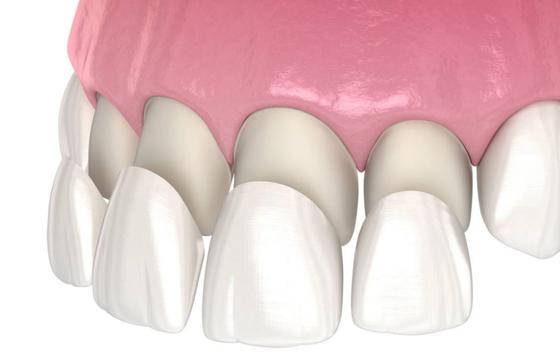
Private Nanodent Oral and Dental Health Center
- Akkuyu - Konyaaltı/Antalya
- 9 km from center
- 22 km to Airport
- Özel Nanodent Ağız Ve Diş Sağlığı Merkezi
Veneers provide patients with a flexible and efficient way to improve the appearance of their mouths, which makes them an important component of esthetic dentistry. Veneers can be a useful treatment for minor chipping, discolouration, significant gaps between teeth and smaller teeth. So why to use them and which types?

Veneers are thin, precisely crafted shells composed of materials that match the color of teeth that are bonded to the front of teeth to enhance their appearance. Their main purpose is to fix several dental flaws such gaps between teeth, discolouration, staining, chipping, and misalignment. Veneers offer a long-lasting, natural-looking way to improve the smile's appearance.
The process of getting dental veneers typically involves several steps and may span over the course of a few weeks. Here's a general overview of the timeline for the dental veneers process,
Initial Consultation (1 visit), Treatment Planning and Preparation (1 visit), Fabrication of Veneers (1-2 weeks), Veneer Placement (1-2 visits), Follow-Up Visit (Depends of your dentists schedule).
Porcelain Veneers, are made of high-quality dental ceramic that closely resembles natural tooth enamel in color, translucency and texture. Porcelain veneers are custom-fabricated in a dental laboratory based on impressions of the patient's teeth. When properly cared for, they are extremely resilient, stain-resistant, and have a long lifespan. Veneers seem natural and usually require little tooth preparation. Veneers are typically require minimal tooth preparation and offer a lifelike appearance, making them a popular choice for cosmetic dental procedures.
Composite Resin Veneers, the dentist shapes and applies tooth-colored composite material directly to the teeth to create composite resin veneers. Composite veneers can be completed in just one visit because they are made chairside during the dental consultation, in contrast to porcelain veneers. Compared to porcelain veneers, composite resin veneers are more reasonably priced and easily modifiable in the event of damage or discoloration. However, compared to porcelain veneers, they are typically less durable and could need more regular upkeep and replacement.
Zirconia veneers, are a type of dental veneer made from zirconium oxide, a high-strength ceramic material known for its durability, biocompatibility and aesthetic properties. Zirconia veneers offer several advantages and are becoming increasingly popular in cosmetic and restorative dentistry.
E-max veneers are a type of dental veneer made from lithium disilicate ceramic, known for its strength, durability, and esthetic qualities. E-max veneers are made to order to precisely mimic the patient's original teeth in terms of size, shape, and color. CAD/CAM dental systems and sophisticated digital technology enable exact fit and customization of e.max veneers.
Lumineers are a unique form of veneer that is exclusively available through select practitioners, made by DenMat dental laboratory. Applying Lumineers is quicker, less expensive, and thinner. But it's not as easy as you might assume to select the appropriate kind of veneer.
Porcelain veneers are crafted from high-quality dental ceramic that closely mimics the appearance and translucency of natural tooth enamel.
Composite resin veneers are made of tooth-colored composite material that is directly applied and shaped on the teeth.
Zirconia veneers are fabricated from zirconium oxide, a white crystalline oxide of zirconium. Zirconia is known for its exceptional strength and resistance to fracture, making it an ideal material for dental restorations.
E.max veneers are crafted from lithium disilicate ceramic, which is a type of glass-ceramic material. This material is prized for its exceptional strength and durability, making it suitable for dental restorations.
Selecting the appropriate veneer type depends on taking consideration a range of factors such as your desired cosmetic result, your oral health, your budget, and your dentist's suggestions. Here is a guide to assist you in making a well-informed choice.
Consultation with a Dentist, schedule a consultation with a qualified cosmetic dentist to discuss your goals and concerns regarding your smile. Your dentist will evaluate your oral health, assess the condition of your teeth and discuss the various treatment options available.
Aesthetic Goals, clearly communicate your aesthetic goals and expectations to your dentist. Describe the changes you'd like to see in your smile, such as tooth color, shape, size and alignment.
Types of Veneers, Learn about the different types of veneers available, including porcelain, composite resin, e.max, and zirconia veneers. Consider factors such as durability, aesthetics, longevity, and maintenance requirements when choosing the right type of veneers for your needs.
Price, your budget when choosing the type of veneers. Porcelain and e.max veneers tend to be more expensive than composite resin and zirconia veneers.
Long-Term Maintenance, requirements of each type of veneer. Porcelain and e.max veneers are highly durable and stain-resistant but may require occasional adjustments or replacements over time
The process of getting dental veneers typically involves several steps and may span over the course of a few weeks. Here's the timeline for the dental veneers,
First Consultation (1 Visit), objectives and worries at the first consultation. In order to decide whether veneers are right for you, your dentist will examine your teeth and oral health. Additionally, you'll go over the many kinds of veneers that are available, their benefits, and drawbacks.
Planning and Preparing for Treatment (1 Visit), Your dentist will make molds of your teeth if you choose to move forward with veneers. X-rays and pictures may also be taken by your dentist to help with treatment planning. In certain situations, tooth preparation could be required to make room for the veneers' thickness. This entails polishing a tiny layer of enamel off the teeth's front surface.
Veneer fabrication, takes one to two weeks. A dental laboratory receives the imprints along with other relevant documents, and uses these to create veneers that are precisely sized, shaped, and colored to resemble your own teeth. Your teeth may be protected throughout this procedure, which normally takes one to two weeks, by temporary veneers.
Veneer placement (1-2 visits), you will make an appointment to have the veneers placed once they are ready at the dentist's office. Using dental cement, your dentist will gently attach the veneers to your teeth. To guarantee a natural appearance and a good fit, the veneers will be polished and adjusted. Depending on how many veneers are being installed, this appointment could last several hours or perhaps numerous visits.
Follow-Up Appointment, in order to assess the veneers' fit and functionality and make any required corrections, your dentist may arrange a follow-up appointment. You can also go over veneer maintenance advice and post-placement care recommendations during this session.
Generally, receiving dental veneers requires two to three appointments spread out over several weeks. The amount of veneers being placed, the intricacy of the case, and the particular treatment plan your dentist has decided upon could all affect the timing. To guarantee the finest result for your smile, it's critical to keep in contact with your dentist and heed their advice at every stage.
Traditional dental veneers are not the only option available when considering cosmetic dental modifications; each has pros and downsides of its own. These are a few substitutes for dental veneers.
Teeth whitening, that can effectively lighten the color of natural teeth. It is an excellent option for patients with mild to moderate tooth discoloration caused by aging, smoking, or consumption of staining substances like coffee or tea.
Dental bonding, involves the application of tooth-colored composite resin to the teeth to improve their appearance. It can be used to repair chipped or cracked teeth, close small gaps between teeth, and reshape misaligned or uneven teeth. Dental bonding is a more affordable alternative to veneers and typically requires minimal tooth preparation.
Orthodontic treatment, such as braces or clear aligners, can be used to straighten misaligned teeth and correct bite issues. While orthodontic treatment may take longer than veneers or bonding, it offers a permanent solution for improving the alignment and function of the teeth.
Dental crowns, are tooth-shaped restorations that cover the entire visible portion of a tooth above the gum line. Crowns are often used to restore severely damaged or decayed teeth, as well as to improve the appearance of misshapen or discolored teeth. Unlike veneers, crowns require more extensive tooth preparation and removal of tooth structure.
Before choosing a cosmetic dental treatment, it's essential to consult with a dentist to discuss your specific concerns, goals, and treatment options. A dental professional can evaluate your oral health and recommend the most appropriate treatment plan to achieve the desired results for your smile.
Dental veneers are frequently advised for people who are self-conscious about the way their teeth look. These are a few typical justifications for considering dental veneers,
Tooth Discoloration, veneers may be a good option for teeth that are very discolored or stained and do not react well to conventional teeth-whitening procedures. Veneers can successfully cover intrinsic stains, such as those brought on by certain drugs, fluorosis or dental trauma, giving the smile a more even and brighter appearance.
Broken or Worn Teeth, veneers can fix broken, worn-down, or mildly fractured teeth by improving their look. With veneers, the overall symmetry and contour of the smile can be improved by covering the damaged areas with specially constructed shells.
Uneven or Irregularly Shaped Teeth, veneers can be used to change teeth that are uneven in shape, crooked, or have uneven edges. Veneers improve the size, shape, and alignment of the teeth to help produce a more balanced and harmonious smile.
Gaps and spaces between teeth, veneers can close these types of gaps and spaces between teeth to provide the appearance of a more consistent and beautiful smile. Veneers manufactured to order fill in the gaps, giving the teeth a more uniform and straight appearance.
Dental veneers offer several benefits for individuals seeking to improve the appearance of their smiles. However, like any dental procedure, there are also potential risks and limitations to consider. Here are the benefits and risks of dental veneers.
Benefits,
Enhanced Aesthetics, veneers can dramatically improve the appearance of the smile by covering stains, discoloration, chips, cracks and other imperfections. They provide a natural-looking and aesthetically pleasing result.
Customization, to ensure a smooth and natural-looking result, veneers are produced to precisely match the patient's original teeth in terms of size, shape and color. For a customized smile makeover, they can be shaped to obtain the required tint, translucency and contour.
Minimally Invasive, compared to some other cosmetic dental treatments, such as dental crowns, veneers typically require minimal tooth preparation. This means that less enamel may need to be removed from the teeth, preserving more of the natural tooth structure.
Stain Resistance, porcelain veneers are highly resistant to staining and discoloration, allowing patients to enjoy a bright and vibrant smile for years to come. They offer superior color stability compared to natural tooth enamel and composite resin materials.
Veneers made from high-quality materials, such as porcelain or lithium disilicate, are highly durable and can withstand the rigors of daily oral function. With proper care and maintenance, veneers can provide long-lasting esthetic enhancements to the smile. Many aesthetic issues, like as tooth discolouration, chipping, cracks, gaps, and little misalignments, can be resolved with veneers. They provide an adaptable way to get the best aesthetic outcomes and improve the smile's overall appearance.
Risks and Limitations,
Irreversible, the process of getting veneers typically involves the removal of a thin layer of enamel from the front surface of the teeth. This irreversible step means that once enamel is removed, it cannot be replaced.
Sensivity, some individuals may experience temporary tooth sensitivity following the placement of veneers, especially if enamel removal is involved in the process. This sensitivity usually resolves on its own over time but can be a concern for some patients.
Cost, of dental veneers can vary depending on factors such as the type of veneer, the number of teeth being treated, and the geographic location of the dental practice.
Potential complications, In rare cases, complications such as veneer detachment, fracture or debonding may occur.
The duration of dental veneers can vary depending on several factors, including the type of veneer, the quality of materials used, oral hygiene practices and lifestyle habits. In general, they last for many years and provide long-lasting esthetic enhancements to the smile. Some factors to consider regarding the longevity of dental veneer are,
Type, porcelain veneers are known for their durability and longevity compared to composite resin veneers. They are highly resistant to staining, chipping and wear, offering superior longevity and color stability.
Quality of Materials, used in the fabrication of veneers can influence their longevity. High-quality porcelain or lithium disilicate veneers made from reputable manufacturers tend to offer better durability and esthetics.
Good oral hygiene habits, including regular brushing, flossing,and routine dental check-ups, can help maintain the health and longevity of veneers.
Lifestyle Habits, such as smoking, excessive consumption of staining substances (coffee, tea, alcohol) and habits like teeth grinding (bruxism), can affect the longevity of veneers.
Dental veneers are considered a long-lasting cosmetic dental solution, they are not permanent restorations and may eventually require replacement over time. On average, veneers can last anywhere from 10 to 15 years or more with proper care and maintenance. Some veneers may last even longer, depending on individual factors.
Modern dental materials and methods allow veneers to closely resemble real teeth. Porcelain veneers, in instance, have a transparent quality akin to tooth enamel, creating a realistic and lifelike look. Your dentist will carefully match the color and form of the veneers to your natural teeth for a flawless integration.



*The treatment pages provided on this platform are intended for informational purposes only and do not constitute medical or dental advice, diagnosis, or treatment recommendations. The information presented on these pages is not a substitute for professional medical or dental advice from qualified healthcare providers.
*By accessing and using the treatment pages on this platform, you acknowledge and agree to the terms of this disclaimer. If you do not agree with these terms, please refrain from using the treatment pages.